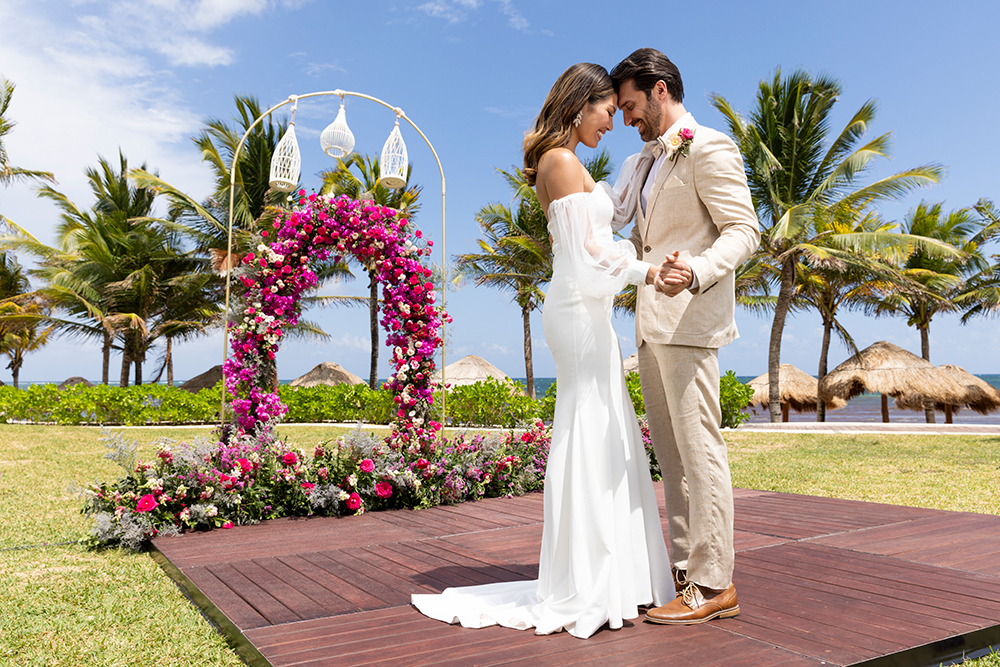Here's the inside track to planning your perfect wedding menu.
Whether you and your fiancé have your hearts set on a lavish selection of truffle-infused haute-foodie delights or a cozy comfort-food buffet, you’ll want to start with the right caterer. To that end, we asked chef Ro Howe, owner of Barraud Caterers in New York City, for the step-by-steps.

One of the highlights of wedding planning is getting to sample a range of delicious fare from talented chefs. Photo credit: Lisa Koening
6 to 11 Months Before
Reach out. Contact five or six catering companies, tops, Howe advises. Casting a wider net will only cause you to lose concentration—as well as precious time.
Make a list. Before you pick up the phone, put together some initial questions to ask each caterer: “You may want to know if the caterer can accommodate vegetarians, pair and select wines or arrange tenting,” Howe says. “You may also want to know if she and her team can travel outside of your local area.”
Start with broad strokes. With each initial contact, convey the basics: “Your wedding date, the venue, guest number,” Howe says. You’ll also have your list of questions, “but be sure to allow the caterer to ask you questions, too.” During this fact-finding conversation, “The caterer will tell you what areas her charges cover. If not, ask. The company may not cover alcohol or the cake.” At the end of the call, let each caterer know you will get back to him or her.
Next steps. Take notes during your calls, and write up your reactions to each caterer as you go. “This will help refine your search.” Howe says. At this point, you may decide to cross one or two caterers off your list. “Be sure to send a polite e-mail saying you have decided to go in a different direction.”
4 to 9 Months Before
Take a meeting. It’s getting serious. Set up appointments with the caterers on your shortlist—now’s the time to do a deeper dive into logistics—and costs. “Sit-down dinner, dégustation tasting with wine pairing, ceremony and brunch on site, lunch, dinner or a midnight snack—whatever scenario you imagine can be structured into a celebration,” Howe says. “The structure informs the staffing and service, equipment rental, bar service and, of course, cost.”
Follow up. “After these meetings, each caterer should present you with an initial proposal and cost estimate,” Howe says. “If it falls within or close to your budget and you feel this caterer is worth considering, a tasting is the next step.” At this point, you should narrow the field to “no more than three caterers,” Howe says. (Again, sending a quick thank-you to the also-rans is the polite thing to do.)

Photo credit: RO Howe, Sachiko Windbiel
3 to 8 Months Before
The fun part—the tasting. There are three “flavors”: The backstage tasting, where you go behind the scenes at an event and sample the caterer’s offerings in the kitchen (least preferable); the open-house tasting, hosted for several potential clients and the private tasting, held for you and your fiancé. “The private tasting is the best option,” Howe says. “It’s the perfect opportunity to have a cogent discussion about the wedding menu and structure, so the caterer can present you with a revised proposal.”
Last round. The “finalists” will submit revised proposals post-tasting. “This should detail exactly what the caterer will be supplying,” Howe says—the food, obviously, as well as other possible line items like linens, tableware, serving and kitchen staff, alcohol and how much each costs.
2 to 7 Months Before
Set the deal. “The proposal also clarifies the payment structure and can serve as the contract with an agreement page, with appropriate signature areas for both parties,” says Howe. There’s still opportunity to make revisions and tweaks, but at this point, making your final choice should be an easy decision. Once you’ve signed on the dotted line, relax—and look forward to some seriously memorable eats.



